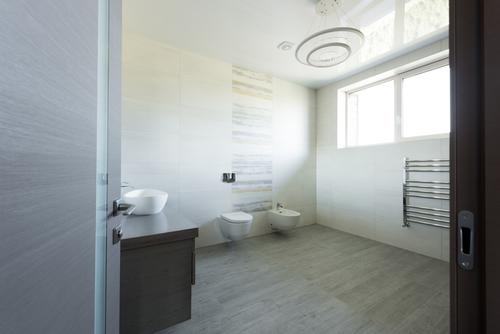Those hot, steamy showers you love so much can become a problem if your bathroom fan isn’t turning on or pulling air. Dusting and cleaning the fan and motor might help. If not, you can replace a broken bathroom fan motor or get a new unit.
Many bathroom fan motors simply plug in, so you don’t need to mess with wiring. You should still look for signs of wiring damage: rust, frayed wires, torn or missing insulation, burnt wire connectors, or sloppy splicing. If any part of the motor unit looks bad, ask a local electrician to take a look. Don’t just replace the fan motor and call it a day.
Troubleshooting a Broken Bathroom Fan

Here’s what you should have ready to repair a bathroom fan:
- A ladder
- A vacuum, dust buster, or duster cloths
- Phillips and flat screwdrivers
- Spray cleaner or dish soap
- Lightweight lubricating oil
- Circuit tester
Turn off the circuit breaker to the bathroom and double-check that power is off with your circuit tester. Then remove the fan cover on the ceiling or access the unit from the attic above. Now you need to dust and clean the area. If there is heavy debris, perhaps that’s all you need to do.
Old, worn-out, or broken bathroom fans will be easy to recognize. The metal parts have probably corroded or burnt out.
Was your bathroom fan not turning on at all? Check that everything is firmly plugged in and wire connections are tight. Who knows, perhaps a squirrel chewed something.
Next steps would be to lubricate the fan motor and clean the fan blades. But again, if the wiring looks damaged or burnt, don’t bother with this—you’ll need a bathroom fan replacement.
Time to Upgrade? Replace a Broken Bathroom Fan
A broken bathroom fan must have shut down for a reason—you leave it running for hours because there isn’t a timer switch, the wiring has rusted, or perhaps the fan is simply too old. Consider asking an electrician to install a new bathroom fan unit. The process does not have to be invasive or involve opening up the ceiling; there’s just a little bit of electrical wiring involved.
Options when replacing a broken bathroom fan include:
- Change to a bathroom fan and light combo (requires slightly different electrical wiring)
- Upgrade to a more powerful bathroom fan with a CFM rating at least as high as the square footage of the room
- Get a quieter bathroom fan with a low sone rating
- Add a timer switch so the bathroom fan can run an adequate amount of time after a shower
- Move the bathroom fan vent to the outside of the home instead of the attic
As always, be safe when troubleshooting a bathroom fan that’s noisy or broken. Contact an electrician in Sebastopol to schedule a quick visit for electrical repair or replacement if you are not familiar with wiring or have any trouble dealing with the fan motor.

